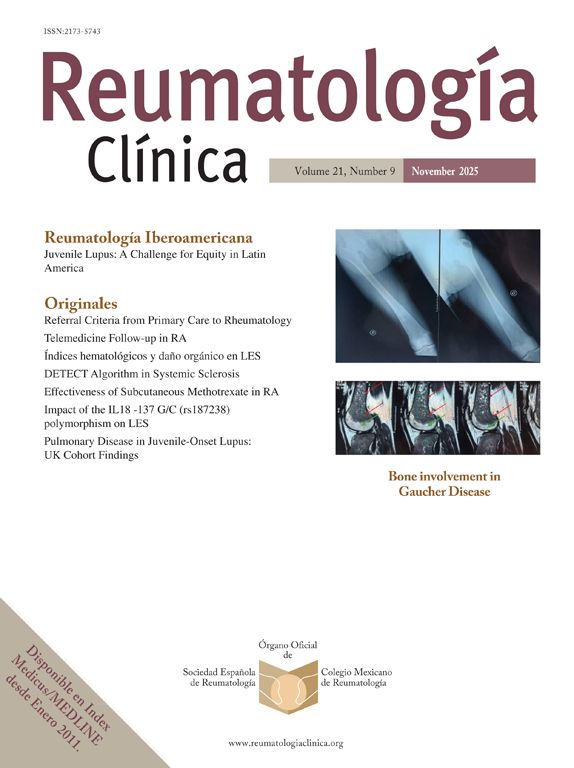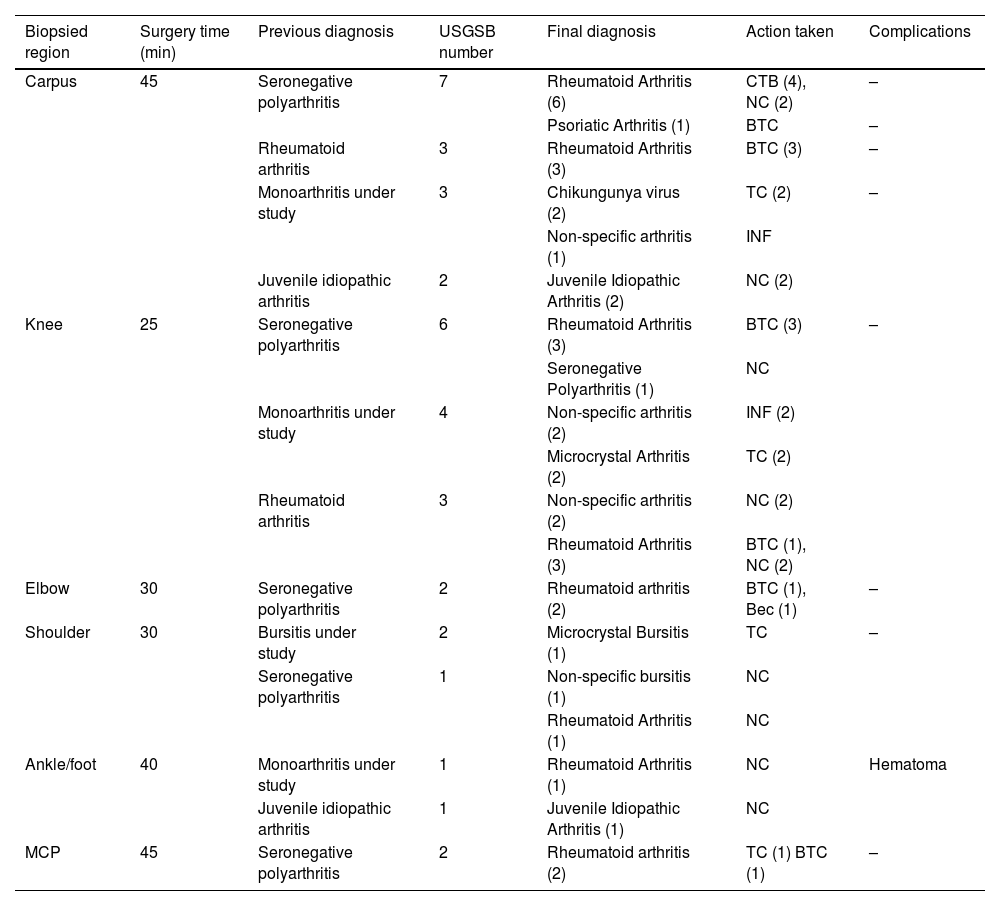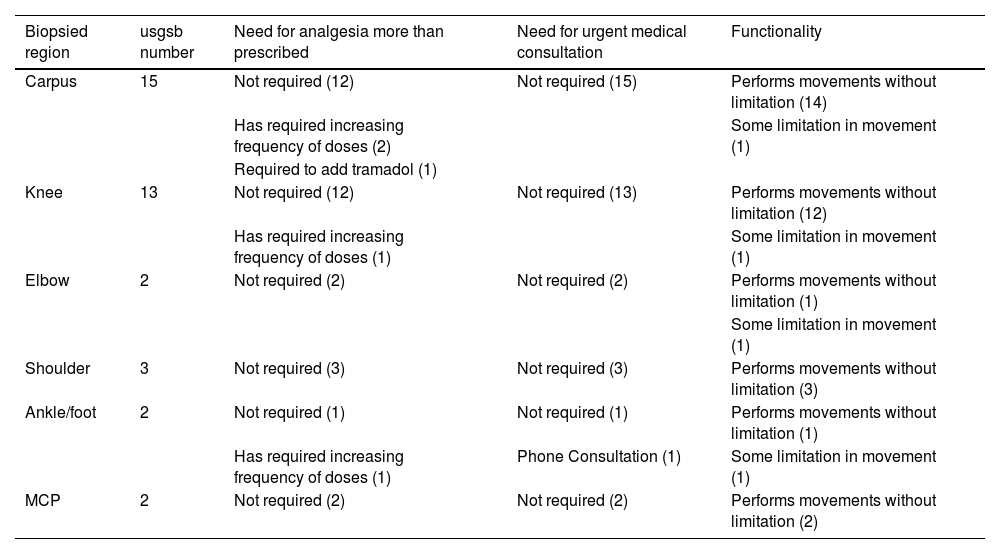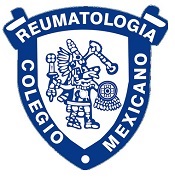Ultrasound-guided synovial biopsy is a procedure for diagnostic and research purposes that is not yet available in most rheumatology departments.
MethodsWe describe the experience with synovial biopsy procedures in our department.
ResultsThirty-eight synovial biopsies were performed on 33 patients during observation. The patients' mean age (standard deviation) was 59 (17) years, ranging between 26 and 90 years. The most frequently biopsied territories were the carpus and the knee. No complications occurred during the procedures. Sixteen residents were trained in the procedure. Two joint sessions have been held with the Immunology and Anatomical Pathology services, and our service sessions have been organised based on the scope and usefulness of the procedures.
ConclusionsOur service's experience has been positive regarding patient care and resident training. The procedure has had no serious complications and has been, in general, very well tolerated.
La biopsia sinovial ecoguiada es un procedimiento con propósitos diagnósticos o de investigación no disponible aún en la mayoría de servicios de reumatología.
MétodoRealizamos una descripción de la experiencia en el procedimiento de biopsias sinoviales en nuestro servicio.
ResultadosSe han realizado 38 biopsias sinoviales a 33 pacientes a lo largo del periodo de observación. La media de edad (desviación estándar) de los pacientes fue 59 (17) años con rango entre 26 y 90 años. Los territorios biopsiados con mayor frecuencia fueron el carpo y la rodilla. No se produjo ninguna complicación durante los procedimientos. Se han formado en el procedimiento a 16 residentes. Se han realizado dos sesiones conjuntas con los servicios de Inmunología y Anatomía Patológica y se han organizado sesiones propias del servicio sobre alcances de la utilidad de los procedimientos.
ConclusionesLa experiencia obtenida en nuestro servicio ha sido positiva en términos asistenciales y formativos. El procedimiento no ha tenido complicaciones y ha sido, en general, muy bien tolerado.
Ultrasound-guided synovial biopsy (USGSB) is an invasive procedure performed to obtain joint synovial tissue by means of a targeted puncture in real time with the assistance of conventional musculoskeletal ultrasound.1,2 This procedure also enables other specific tissues to be obtained, depending on the clinical need, such as tenosinovial, bursal synovia,3,4 epitenon or even enthesal tissue.5 Adequate diagnostic capability for USGSB has been demonstrated, when compared to arthroscopic or open biopsies, a fact that gives this technique an additional advantage by minimising the invasive nature of the diagnostic process.3,6,7 Purely Spanish scientific production over the last 5 years in this practice, has been scarce;8.9 however, its potential usefulness in improving therapeutic precision has been sufficiently demonstrated.8,10–14
Throughout the first half of 2023, the Ramón y Cajal Hospital Rheumatology Unit implemented development of this procedure with the coordination of the surgical sub-directorate and the Anaesthesia and Resuscitation, Immunology and Pathological Anatomy units.
In June 2023, our unit performed the first 4 ynovial biopsies and since then it has maintained one operating theatre day per month for the performance of these procedures. The purpose of this study was to describe the experience obtained in the first year since the implementation of this technique.
Material and methodThis was a descriptive, retrospective study that covers the work undertaken in the rheumatology operating theatre over the first year, between June 2023 and June 2024.
The source of information used was the surgical reports on all the procedures performed, along with the corresponding data obtained from the medical records of the patients who were indicated for a USGSB.
Human resourcesThree rheumatologists who were experts in musculoskeletal ultrasound were trained in synovial biopsy throughout 2022–2023 in different specific training programmes. Each procedure was performed in the presence of 2 rheumatologists and 2 third- and fourth-year rheumatology residents, either from the unit or external rotating personnel. Each procedure was performed at the same time by both an assistant and a resident, so that, between procedures, a team of 2 human resources were preparing the next patient or drafting the surgical report on the previous patient. All residents taking part in the operating theatre work had been through the ultrasound rotation of one month in the second year of residency and 3 months in the third. In the case of external rotations in the Imaging and Ultrasound-Guided Procedures Unit (USGPU), their involvement was in the third month of their rotation.
Logistical resourcesThe surgical sub-directorate at our centre assigned an operating theatre to our unit in the outpatients’ surgical procedures unit, where other specialties such as urology, dermatology or otorhinolaryngology performed procedures. The rheumatology operating theatre had the same facilities as a conventional operating theatre and was assigned to a 7 h anaesthesiology shift in which up to 5 procedures could be performed on the same day. Although the performance of a synovial biopsy did not require the presence of an anaesthesiologist or access to an operating theatre and, according to the literature, this can be performed in a clean room with the assistance of auxiliary personnel,2,7,15 in our unit the use of the operating theatre was chosen for 2 reasons: 1) to offer maximum comfort and for the well-being of the patient during the procedure, and 2) because there was no clean room cleaning staff available between procedures, or auxiliary personnel for exclusive service during synovial biopsies.
The Rheumatology Service provided a portable MyLab Sigma ultrasound machine™ from the commercial company ESAOTE, equipped with a 23 MHz hockey stick probe and an 8−13 MHz linear probe. The operating theatre material included 3 biopsy needle measurements that were selected by the team of rheumatologists responsible for the USGSB after evaluation of different models and brands. The small biopsy needle reserved for metacarpophalangeal and interphalangeal joints was not equipped with a guidewire cannula, while the medium and large needle, which was used in the rest of the joints, had a cannula that was inserted beforehand, was located with the ultrasound guide and enabled the sampling procedure to be repeated without the need for further punctures.
The rheumatology operating theatre shift was coordinated every four months with the immunology and pathology departments. The immunology unit was responsible for the flow cytometry process which, in turn, required prior processing of the tissues by enzymatic digestion to facilitate the exposure of cell receptors. This pre-procedure requires 6 h and should be started immediately after the sample has been obtained. For this reason and with the limitation of the availability of personnel in this laboratory, the last sample had to be processed at 12:00 so, finally, the number of procedures that could be performed in order to obtain a cytometric analysis, were 3 or 4. The pathological anatomy unit was responsible for the conventional histological study of the tissue samples sent. Unless specifically requested, the report included data on architecture and composition (Krenn scale) and specific histochemical or microbiological studies could be requested.
Administrative assistance proceduresIn our unit, the performance of synovial biopsies has been proposed in the following situations: synovitis where the intention is to exclude infections, diagnostic uncertainty between 2 or more probable processes, and synovial study of patients with failure to respond to 3 or more biological therapies.
The proposal of the procedure to the patient is made by the clinician responsible for each case, which includes signing an informed consent. The case is discussed with the rheumatologists who perform the USGSB, and they schedule an ultrasound examination if this has not been previously done or if it has not been undertaken recently. Once the consent has been signed, the patient is scheduled for a pre-anaesthesia consultation (for which it is not necessary to request laboratory tests) and is finally scheduled for the rheumatology operating theatre.
On the day of the procedure, an exploratory ultrasound is performed before entering the operating theatre to ensure the availability of tissue and to plan the procedure between the doctors involved. Once in the operating theatre, the decision is taken as to whether to perform a regional block, or conventional sedation with supervision by the anaesthesiologist in all cases.
The procedure is performed in teams of 2 (one assistant and one resident) and can be conducted by one single or 2 operators in a two- or four-handed procedure, respectively. In the 4-handed procedure, one operator maintains the positioning of the probe while the second manipulates the biopsy needle. In the 2-handed procedure, a single operator is responsible for holding the probe in position and also handling the needle. In all cases, the management of the samples is handled by the surgical nursing staff and the transportation to the corresponding laboratories is done by the operating theatre assistant staff.
Synovial tissue samples sent to the immunology laboratory are inserted into a saline tube, 3 per tube according to the region of interest (usually one region of interest per USGSB). Tissue samples for the study of pathological anatomy are sent in formaldehyde in threes or fours by region of interest.
Immunology results can be available in 48 h and pathological anatomy results in approximately 3–4 weeks.
At the end of the procedures, patients are clinically re-assessed and are given a report with the detail of the procedure performed and analgesic recommendations. After performing the USGSB, the residents taking part contact the patients 72 h after the USGSB to corroborate their general well-being and the absence of complications. Throughout this period, patients can contact the unit in case of urgent assessment needs during working hours and, outside working hours, the emergency department of our centre.
ResultsProcedures performed38 USGSBs were performed on 33 patients over the period described, of which 22 were female. The mean age (standard deviation) of the patients was 59 (17) years with a range between 26 and 90 years. Two patients scheduled for USGSB) finally rejected the procedure.
USGSB was performed in all peripheral articular regions with the exception of the coxofemoral joint. Table 1 summarises the characteristics of the procedures performed.
Summary of the procedures performed.
| Biopsied region | Surgery time (min) | Previous diagnosis | USGSB number | Final diagnosis | Action taken | Complications |
|---|---|---|---|---|---|---|
| Carpus | 45 | Seronegative polyarthritis | 7 | Rheumatoid Arthritis (6) | CTB (4), NC (2) | – |
| Psoriatic Arthritis (1) | BTC | – | ||||
| Rheumatoid arthritis | 3 | Rheumatoid Arthritis (3) | BTC (3) | – | ||
| Monoarthritis under study | 3 | Chikungunya virus (2) | TC (2) | – | ||
| Non-specific arthritis (1) | INF | |||||
| Juvenile idiopathic arthritis | 2 | Juvenile Idiopathic Arthritis (2) | NC (2) | |||
| Knee | 25 | Seronegative polyarthritis | 6 | Rheumatoid Arthritis (3) | BTC (3) | – |
| Seronegative Polyarthritis (1) | NC | |||||
| Monoarthritis under study | 4 | Non-specific arthritis (2) | INF (2) | |||
| Microcrystal Arthritis (2) | TC (2) | |||||
| Rheumatoid arthritis | 3 | Non-specific arthritis (2) | NC (2) | |||
| Rheumatoid Arthritis (3) | BTC (1), NC (2) | |||||
| Elbow | 30 | Seronegative polyarthritis | 2 | Rheumatoid arthritis (2) | BTC (1), Bec (1) | – |
| Shoulder | 30 | Bursitis under study | 2 | Microcrystal Bursitis (1) | TC | – |
| Seronegative polyarthritis | 1 | Non-specific bursitis (1) | NC | |||
| Rheumatoid Arthritis (1) | NC | |||||
| Ankle/foot | 40 | Monoarthritis under study | 1 | Rheumatoid Arthritis (1) | NC | Hematoma |
| Juvenile idiopathic arthritis | 1 | Juvenile Idiopathic Arthritis (1) | NC | |||
| MCP | 45 | Seronegative polyarthritis | 2 | Rheumatoid arthritis (2) | TC (1) BTC (1) | – |
Bec: surgical bursectomy; BTC: biological or advanced therapy change; INF: scheduling of infiltrations; MCP: metacarpophalangeal joint; NC: No change; TC: treatment change; USGSB: ultrasound-guided synovial biopsy.
The mean time in the operating theatre per patient was 95 min, taken from the time of entry to the operating theatre until the drafting of the operation report. Approximately, the time spent on the procedure itself ranged from 25 to 45 min (Table 1).
As regards the approaches used to carry out the USGSBs, these were the following: for carpal biopsy, the distal radioulnar joint was targeted, approaching ulnar-dorsally; for the USGSB of the second MCF joint, the approach was radially; for shoulder USGSB, posterior access at the level of the labrum was the approach for the study of the synovium, and lateral anterior access for the study of the bursa; for elbow USGSB, access was posteriorly and laterally, targeting the olecranon fossa, although in one patient the anterior access was adopted, with a lateral approach, bypassing the humeral artery and targeting the condyle-radial synovium; for the knee, the approach was through the external parapatellar recess; and for the ankle, access to the tibiotalar joint was by the lateral approach.
Usefulness of the samplesThroughout the period described, there was no loss of samples due to means of transport. In one patient, a sufficient synovial tissue sample could not be obtained for the study.
The motivation or indication for USGSB in the 33 patients was due to diagnostic needs (differential diagnosis, diagnostic confirmation, or diagnostic uncertainty) in 20 cases, and due to poor or insufficient treatment response in 16 cases. Both indications coexisted in 3 patients. Three diagnoses of infectious diseases were reached (2 for chikungunya virus, one diagnosis of microcrystalline arthritis due to hydroxyapatite, one diagnosis of disease due to calcium pyrophosphate crystal deposition, two diagnoses of amyloidosis, and one diagnosis of psoriatic arthritis). A total of 16 diagnoses of seronegative rheumatoid arthritis were ratified.
Table 1 summarises the previous diagnoses, final diagnoses reached, and clinical attitudes after the USGSB results were known. These changes in attitude correspond to the review of the evolutionary changes immediately following the assessment of the result of the USGSB, although the decision may have been taken without considering that result exclusively, but also taking other evaluation parameters, together with the result of the USGSB.
ComplicationsNo complications occurred during the performance of the USGSB. No patient required analgesia rescue beyond the regimen performed at discharge, on the day of the procedure. There was no need for prostration or specific rest in the case of any patient. One patient presented with a local haematoma on the ankle, at the level of the puncture site, which was resolved with physical measures and prolongation of analgesia. Table 2 summarises the condition of the patients 72 h after the USGSB had been performed, in line with the further treatment undertaken by the resident physicians who took part in the procedures.
Summary of 72-h assessments of ultrasound-guided synovial biopsies.
| Biopsied region | usgsb number | Need for analgesia more than prescribed | Need for urgent medical consultation | Functionality |
|---|---|---|---|---|
| Carpus | 15 | Not required (12) | Not required (15) | Performs movements without limitation (14) |
| Has required increasing frequency of doses (2) | Some limitation in movement (1) | |||
| Required to add tramadol (1) | ||||
| Knee | 13 | Not required (12) | Not required (13) | Performs movements without limitation (12) |
| Has required increasing frequency of doses (1) | Some limitation in movement (1) | |||
| Elbow | 2 | Not required (2) | Not required (2) | Performs movements without limitation (1) |
| Some limitation in movement (1) | ||||
| Shoulder | 3 | Not required (3) | Not required (3) | Performs movements without limitation (3) |
| Ankle/foot | 2 | Not required (1) | Not required (1) | Performs movements without limitation (1) |
| Has required increasing frequency of doses (1) | Phone Consultation (1) | Some limitation in movement (1) | ||
| MCP | 2 | Not required (2) | Not required (2) | Performs movements without limitation (2) |
Throughout the period indicated, 16 residents attended the rheumatology operating theatre, 8 of them from the unit and 8 external rotating residents. In all cases, the assistants in charge performed the first approach and, depending on the degree of skill demonstrated, the residents performed the procedure once the catheter and cannula had been placed in the desirable positions, or even from the first incision. This training system was consistent with that proposed in the literature,16 although without reaching the capability of performing the procedure autonomously. Two joint sessions were held along with the Immunology and Pathological Anatomy departments and the unit organised its own sessions on the scope of the usefulness of the procedures.
ConclusionsThe experience obtained in our unit regarding the performance of USGSB was positive in terms of medical care and training. This required coordination between four different units and the involvement of multiple physicians.
In our experience, the procedure for performing USGSB had no complications and was very well tolerated without the need for rescue analgesia medication.
We plan to increase the number of operating theatres assigned to 2 procedures per month and to increase the number of procedures per day, in an attempt to take care of enzymatic digestion which limits the performance of cytometric studies, due to the time this takes and, in turn, limits the full usefulness of the time in the operating theatre.
The authors declare that they have no conflict of interest.







